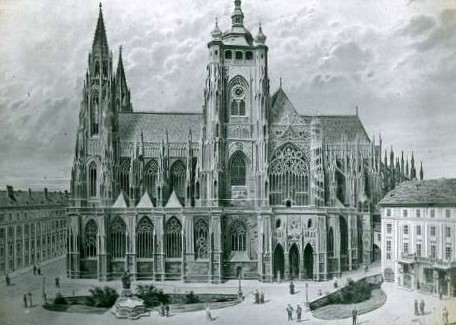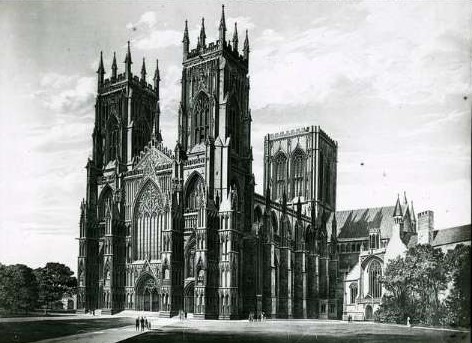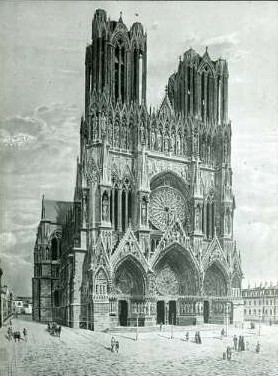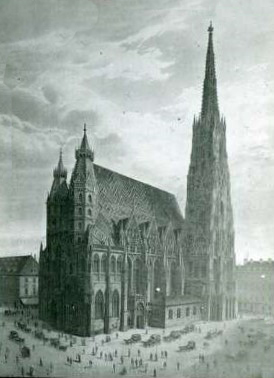Session 42





- 271. Catedral de S. Veith en Praga (Bohemia)
- 275. Catedral de York (Inglaterra)
- 307. Nuestra Señora de París (Francia)
- 308. Catedral de San Esteban en Viena
- 713. Plaza de S. Marcos en Venecia (Italia)
271. Catedral de S. Veith en Praga (Bohemia)
- Registration number BVPB20140001484-01
- Collection title Gótico
- Collection's origin IES El Greco
- Country of origin France
- Manufatured by Mazo Éditeur
- Year 1900-1925
- Dimensions 8,5 x 10 cm
- Genre Artistic
Theme
Artistic
Description
Magic lantern slides catalogued within the artistic genre refer to the visual dissemination of cultural content of Science and the Fine Arts. The term ‘Fine Arts’ became popular in the eighteenth century to refer to the forms of art that developed mainly through aesthetic philosophy, the idealization of beauty and the good use of technology. The first book known to classify the fine arts is Les Beaux-Arts réduits à un même principe (The Fine Arts Reduced to a Single Principle), published in 1746 by Frenchman Charles Batteux, who tried to unify the numerous theories about beauty and liking. Batteux originally included in the Fine Arts: dancing, sculpturing, music, painting, and poetry, though he added later architecture and eloquence. Over time, the list would change according to different authors that added or removed arts to this list: first, eloquence was substracted, and, in 1911, Ricciotto Canudo was the first theorist to qualify cinema as the seventh art in his essay Manifiesto de las siete artes, which was published in 1914. Also, for the historical evolution of the term, it is common for it to be associated —especially in educational institutions and museums— almost exclusively to the plastic or visual arts.
275. Catedral de York (Inglaterra)
- Registration number BVPB20140001484-02
- Collection title Gótico
- Collection's origin IES El Greco
- Country of origin France
- Manufatured by Mazo Éditeur
- Year 1900-1925
- Dimensions 8,5 x 10 cm
- Genre Artistic
Theme
Artistic
Description
Magic lantern slides catalogued within the artistic genre refer to the visual dissemination of cultural content of Science and the Fine Arts. The term ‘Fine Arts’ became popular in the eighteenth century to refer to the forms of art that developed mainly through aesthetic philosophy, the idealization of beauty and the good use of technology. The first book known to classify the fine arts is Les Beaux-Arts réduits à un même principe (The Fine Arts Reduced to a Single Principle), published in 1746 by Frenchman Charles Batteux, who tried to unify the numerous theories about beauty and liking. Batteux originally included in the Fine Arts: dancing, sculpturing, music, painting, and poetry, though he added later architecture and eloquence. Over time, the list would change according to different authors that added or removed arts to this list: first, eloquence was substracted, and, in 1911, Ricciotto Canudo was the first theorist to qualify cinema as the seventh art in his essay Manifiesto de las siete artes, which was published in 1914. Also, for the historical evolution of the term, it is common for it to be associated —especially in educational institutions and museums— almost exclusively to the plastic or visual arts.
307. Nuestra Señora de París (Francia)
- Registration number BVPB20140001484-03
- Collection title Gótico
- Collection's origin IES El Greco
- Country of origin France
- Manufatured by Mazo Éditeur
- Year 1900-1925
- Dimensions 8,5 x 10 cm
- Genre Artistic
Theme
Artistic
Description
Magic lantern slides catalogued within the artistic genre refer to the visual dissemination of cultural content of Science and the Fine Arts. The term ‘Fine Arts’ became popular in the eighteenth century to refer to the forms of art that developed mainly through aesthetic philosophy, the idealization of beauty and the good use of technology. The first book known to classify the fine arts is Les Beaux-Arts réduits à un même principe (The Fine Arts Reduced to a Single Principle), published in 1746 by Frenchman Charles Batteux, who tried to unify the numerous theories about beauty and liking. Batteux originally included in the Fine Arts: dancing, sculpturing, music, painting, and poetry, though he added later architecture and eloquence. Over time, the list would change according to different authors that added or removed arts to this list: first, eloquence was substracted, and, in 1911, Ricciotto Canudo was the first theorist to qualify cinema as the seventh art in his essay Manifiesto de las siete artes, which was published in 1914. Also, for the historical evolution of the term, it is common for it to be associated —especially in educational institutions and museums— almost exclusively to the plastic or visual arts.
308. Catedral de San Esteban en Viena
- Registration number BVPB20140001484-04
- Collection title Gótico
- Collection's origin IES El Greco
- Country of origin France
- Manufatured by Mazo Éditeur
- Year 1900-1925
- Dimensions 8,5 x 10 cm
- Genre Artistic
Theme
Artistic
Description
Magic lantern slides catalogued within the artistic genre refer to the visual dissemination of cultural content of Science and the Fine Arts. The term ‘Fine Arts’ became popular in the eighteenth century to refer to the forms of art that developed mainly through aesthetic philosophy, the idealization of beauty and the good use of technology. The first book known to classify the fine arts is Les Beaux-Arts réduits à un même principe (The Fine Arts Reduced to a Single Principle), published in 1746 by Frenchman Charles Batteux, who tried to unify the numerous theories about beauty and liking. Batteux originally included in the Fine Arts: dancing, sculpturing, music, painting, and poetry, though he added later architecture and eloquence. Over time, the list would change according to different authors that added or removed arts to this list: first, eloquence was substracted, and, in 1911, Ricciotto Canudo was the first theorist to qualify cinema as the seventh art in his essay Manifiesto de las siete artes, which was published in 1914. Also, for the historical evolution of the term, it is common for it to be associated —especially in educational institutions and museums— almost exclusively to the plastic or visual arts.
713. Plaza de S. Marcos en Venecia (Italia)
- Registration number BVPB20140001484-05
- Collection title Gótico
- Collection's origin IES El Greco
- Country of origin France
- Manufatured by Mazo Éditeur
- Year 1900-1925
- Dimensions 8,5 x 10 cm
- Genre Artistic
Theme
Artistic
Description
Magic lantern slides catalogued within the artistic genre refer to the visual dissemination of cultural content of Science and the Fine Arts. The term ‘Fine Arts’ became popular in the eighteenth century to refer to the forms of art that developed mainly through aesthetic philosophy, the idealization of beauty and the good use of technology. The first book known to classify the fine arts is Les Beaux-Arts réduits à un même principe (The Fine Arts Reduced to a Single Principle), published in 1746 by Frenchman Charles Batteux, who tried to unify the numerous theories about beauty and liking. Batteux originally included in the Fine Arts: dancing, sculpturing, music, painting, and poetry, though he added later architecture and eloquence. Over time, the list would change according to different authors that added or removed arts to this list: first, eloquence was substracted, and, in 1911, Ricciotto Canudo was the first theorist to qualify cinema as the seventh art in his essay Manifiesto de las siete artes, which was published in 1914. Also, for the historical evolution of the term, it is common for it to be associated —especially in educational institutions and museums— almost exclusively to the plastic or visual arts.